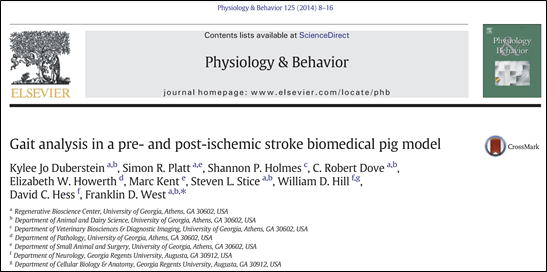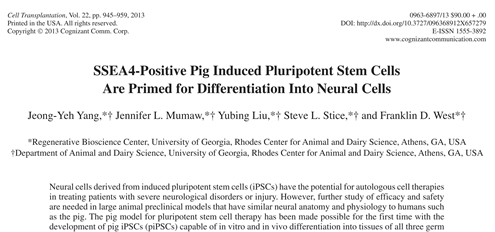Publications
-

Stroke is the leading cause of disability in the United States but current therapies are limited with no regenerative potential. Previous translational failures have highlighted the need for large animal models of ischemic stroke and for improved assessments of functional outcomes. The aims of this study were first, to create a post-stroke functional outcome assessment…
Posted in: Publications -

Induced pluripotent stem cell-derived neural stem cells (iNSCs) have significant potential as an autologous, multifunctional cell therapy for stroke, which is the primary cause of long term disability in the United States and the second leading cause of death worldwide. Here we show that iNSC transplantation improves recovery through neuroprotective, regenerative, and cell replacement mechanisms…
Posted in: Publications -

The pig is the large animal model of choice for study of nerve regeneration and wound repair. Availability of porcine sensory neural cells would conceptually allow for analogous cell-based peripheral nerve regeneration in porcine injuries of similar severity and size to those found in humans. After recently reporting that porcine induced pluripotent stem cells differentiate…
Posted in: Publications -

Efforts to develop stroke treatments have been met with limited success despite an intense need to produce novel treatments. The failed translation of many of these therapies in clinical trials has lead to a close examination of the therapeutic development process. One of the major factors believed to be limiting effective screening of these treatments…
Posted in: Publications -

The present study in Physiology & Behavior evaluated a gait analysis system to study motor function in pig model, determined key gait parameters for assessing normal pig movement, and demonstrated significant changes over time in gait parameters post-stroke. These results support that post-stroke gait analysis is a highly sensitive detection method for dynamic changes in…
Posted in: Publications -

The TNRR Laboratory demonstrates that SSEA4 expression is required for pig neural cells derived from induced pluripotent stem cells (iPSC) to differentiate into neurons, astrocytes, and oligodendrocytes and furthermore develop specific neuronal subtypes. This indicates that the pigs can fill the need for a powerful model to study autologous neural iPSC therapies in a system…
Posted in: Publications -

There is significant progress towards generating informative porcine biomedical models using induced pluripotent stem cells. See Dr. West’s publication in the Annals of the New York Academy of Sciences.
Posted in: Publications